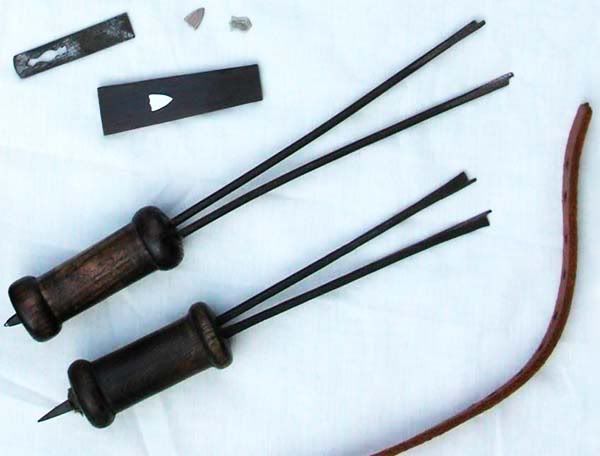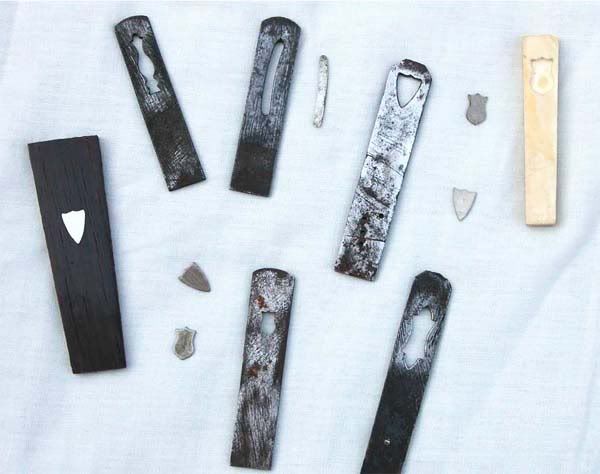Results 1 to 10 of 10
Thread: Transfering inlays
-
05-24-2010, 10:58 AM #1
 Transfering inlays
Transfering inlays
Hi all,
Hoping to hear some thoughts as to how best to transfer this old metal inlay in a stuffed horn scale onto a freshly made one of the same material and shape.
I've read some other threads that touch on this but didn't find any that detail such a process.
This old scale came of a pre 1900 Greaves, it looks like it was once dyed to appear like tortoise shell. The little inlay currently has two very rough prongs that go right through the scale. once I cut it out I think i'll remove these and just sand the inlay down to a flat piece.
I would like to get it flush mounted into the new scale and attach it invisibly somehow.
Looking forward to hearing what others have done along these lines.
Cheers!
-
05-24-2010, 11:16 AM #2

The professor who taught the course in jewelery making I took in college said that when one used only glue when affixing metal to some dissimilar material (wood, plastic, etc.) it would only be a matter of time before the join gave out and the two pieces parted ways. His advice was to always have some sort of a mechanical join to reinforce the glue join. Therefore, since those prongs already exist I for one would choose to take advantage of them and try to use them in the same way on your new scales as they have been employed for fastening the inlays to the old.
Glue + mechanical join = secure fastening
Glue alone =
By the way, it is a shame about those original scales. Judging from your photographs I would say that those were very elegant when new.
-
The Following User Says Thank You to ignatz For This Useful Post:
EisenFaust (05-27-2010)
-
05-24-2010, 11:41 AM #3
-
05-27-2010, 09:40 AM #4
 let me know
let me know
Updating with the progress of the replacement scales.
Here is a pic of the new horn scales, I haven't polished them up yet, only sanded up to 1000 grit so far.
Between them is the little inlay, its very soft so I'm pretty sure it's nickel silver.
It would be installed into the top scale in the picture in the same location as on the originals.
So.. would still love to hear from anyone who has successfully (or unsuccessfully) carried out such a procedure before. Any hints, tips, procedures or advice would be really appreciated.
Thanks!
-
05-27-2010, 09:54 AM #5Senior Member



- Join Date
- Apr 2008
- Location
- Essex, UK
- Posts
- 3,816
Thanked: 3164
I have transferred a few. Both had prongs on the back and were surface mounted on the originals, so that is the way I re-mounted them.
After carefully aligning the escutcheon on the scale, I drilled two holes. Originally the prongs on the back of the escutcheon would have been longer so that they could be peened and then filed for a flush-fit, so the new scales had to be a bit thinner at the mounting position - sanding the inside achieved this. Then the prongs are inserted, a bit of rubber or lead placed on the anvil and the scale placed on it escutcheon side down (rubber or lead helps prevent any damage or flattening). Then the prongs are carefully peened so that they swell in the hole and grip the sides, then the heads are filed off. Job done.
Regards,
Neil
-
The Following User Says Thank You to Neil Miller For This Useful Post:
EisenFaust (05-27-2010)
-
05-27-2010, 10:11 AM #6

Thanks Neil.
I take it by surface mounted you mean pronounced above the plane of the scale? -
Sadly this particular guy was perfectly flush with the surface of the scale, thinking the recess may actually have been cut first with the metal then poured into it molten before being made to match the plane and then decorated. Looks like it might come down to some carefull dremeling on the scale unfortunately to get it down in the new scale.
-
05-27-2010, 10:27 AM #7Senior Member



- Join Date
- Apr 2008
- Location
- Essex, UK
- Posts
- 3,816
Thanked: 3164
They used to use a two-pronged implement called a parser, aka a bow-drill to cut the holes. It has two long prongs, sharpened at the ends. At one end is a bobbin and a boss. The boss went into a plate on the apron or belt of the user, and a cord was wrapped once around the bobbin and joined to a baton - looked like a violinists bow (hence bow drill). The bow was worked up and down, so the prongs rotated through 180 degrees and back again. A steel template of the hole to be cut was clamped to the horn/bone/ivory/tortoiseshell and the ends of the parser were put inside it and a tensioner at the bobbin end adjusted so that they rested against the insides of the template, then the 'bowing' began. They could cut amazingly intricate recesses with this tool very quickly,
An older and less reliable alternative was wet-heating the horn to the point of it becoming plastic, and pushing the plate into it under pressure. If the heat wasn't carefully controlled, the horn could actually melt. There is also the drawback of distortion and warping.
Good luck with the dremel! They have minds of their own - you are OK going in one direction, but when you change direction it wants to skeeter off somewhere else. I have used one before, but I have got a set of wood gravers - scorpers, bullstickers, etc, that are like tiny chisels and are used to engrave boxwood tablets to produce wood engravings - and I used these to cut the outline first and make a kind of 'safety trench' around it before using the dremel to level the insides.
Regards,
Neil.
-
The Following User Says Thank You to Neil Miller For This Useful Post:
EisenFaust (05-29-2010)
-
05-27-2010, 02:43 PM #8Senior Member



- Join Date
- Apr 2008
- Location
- Essex, UK
- Posts
- 3,816
Thanked: 3164
Heres a pic of that twl-legged parser I mentioned and another showing the templates - amazing what it could do!


-
The Following 2 Users Say Thank You to Neil Miller For This Useful Post:
EisenFaust (05-29-2010), Rockabillyhelge (02-15-2014)
-
05-29-2010, 12:56 PM #9

thanks for these pics Neil, what a cool looking thing! - I'm in the process of making such a template - will just be card or plastic but should go someway to helping my tools stay within the bounds of the shape.
-
05-29-2010, 01:22 PM #10

Just out of interest, are you sure those old scales are horn & not tortoiseshell?
Replacements are looking good!


 1Likes
1Likes
 LinkBack URL
LinkBack URL About LinkBacks
About LinkBacks






 Reply With Quote
Reply With Quote
